Paro Travel Guide
A Journey Through the Enchanting Land of Paro: A Travel Guide
Paro is a picturesque valley located in the western region of Bhutan. The valley is known for its stunning natural beauty, ancient culture and tradition, and rich history.
Paro is home to many cultural and historical sites, including the iconic Paro Dzong and the Rinpung Dzong. The Paro Dzong is a 17th century fortress that serves as a Buddhist monastery, and it is an excellent example of Bhutanese architecture. The Rinpung Dzong is also a 17th century fortress and serves as the administrative center of the Paro district.
One of the most iconic attraction in Paro is the Paro Taktsang, also known as Tiger’s Nest Monastery. This sacred Buddhist site is said to have been built in the 8th century and is located on a cliff edge, about 900m above the Paro valley floor. The site can be reached through a moderate hike, and the views from the top of the monastery are breathtaking.
Paro valley is also a great place for trekking. Some of the most popular treks in the area include the Jumolhari Trek, Druk Path Trek, and Snowman Trek. These treks take visitors through beautiful landscapes and provide a chance to see rare species of flora and fauna.
For adventure enthusiasts, there is also an opportunity to experience Paragliding and the hot air balloon. It provides a unique experience of the Paro valley, and an opportunity to see the valley from a bird's eye view.
The best time to visit Paro is between March and May, and between September and November. Visitors should note that the weather in Paro can be unpredictable and it’s essential to be prepared for cold and wet conditions.
Overall, Paro is a magical destination that offers a chance to explore Bhutan's ancient culture, breathtaking natural beauty, and rich history. Visitors will find the rich culture and peaceful atmosphere of the country will leave a lasting impression that will be cherished for a lifetime.
Speak to someone
who's been there

+91-9873003099
MAKE AN ENQUIRYBest Places To Visit In Paro
From historical cities to natural wonders, come see the best of Paro.
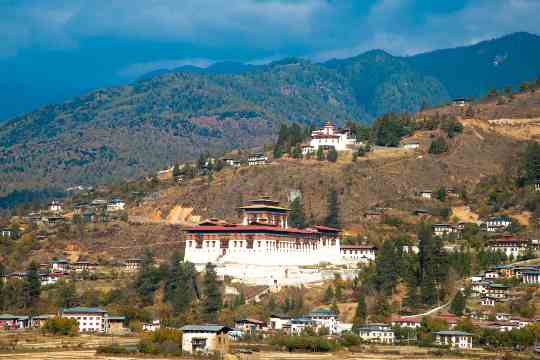
Rinpung Dzong
Rinpung Dzong is a large dzong Buddhist monastery and fort of the Drukpa dynasty of the Kagyu school in Paro district of Bhutan. It houses the district monastic body and the government administrative offices of Paro Dzongkhag. It is listed as a tentative site in Bhutan's tentative list for inclusion in UNESCO. One of the finest examples of architecture, the Rinpung Dzong, also known as Paro Dzong, houses several paintings depicting the life of Buddha in the beautifully lit zong at night. Climbing to the top of the fort welcomes you with a splendid view of the nearby valleys. The colorful annual festival Paro Tshechu is also held in Dzong which makes it more impressive than ever.
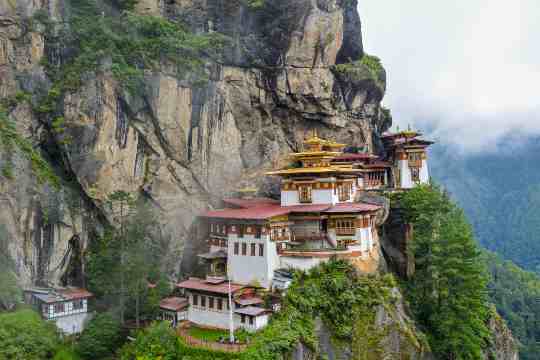
Tiger's Nest Monastery (Paro Taktsang)
Situated in the cliff of the Upper Valley in Bhutan, Paro Takhtsang is a noted Buddhist holy site and is also known as Tiger's Nest or Taktsang Palphug Monastery. The temple has become a folk symbol of Bhutan. Hanging on a precarious rock 10,240 feet above Paro valley, the temple is only possible to reach through a mountainous route. The remote location makes it difficult to reach, but this at the same time makes it a beautiful, unique and unforgettable destination and it is one of the best places to visit in Paro. Reflecting a sophisticated Buddhist architecture, the monastery complex is decorated with white buildings and golden ceilings. Paro Taktsang Monastery has 4 main temples which are connected by steps carved on the rock.

Chele La Pass
Bhutan is filled with mountainous landscapes that are connected by many passes. The highest motorable pass among all the passes in Bhutan is the Chelela Pass which connects the valley of Paro and Ha. It is famous for trekking and hiking trips. The pass is famous for stunning Himalayan scenery, especially Mount Jhomolari which is Bhutan's holiest peak at 22,000 feet, Sherimgung mountain, Jichu Drake as well as views of both valleys, Paro and Ha. The drive to Chele La Pass is through dense spruce and larch forests where you can find many views like yak grazing, frozen river, waterfalls, rhododendron forest and roadside waterfalls.

Paro-Dra-Karpo
One of the many sacred monasteries in Paro is the Dra Carpo which means division of the rock. Where you will find a huge stone that was transferred from the mountain to the altar room. Apart from being a religious place full of faith, it also offers a splendid view of the surrounding valleys. One of the most spiritual places to visit in Paro, it is believed that Guru Rinpoche, who meditated on this hill, broke a rock into pieces and took refuge in an evil spirit; And hence the name "Dra Carpo". The hill is considered very sacred.

Druk Choeding
Built by Ngwang Chogyel in the 15th century, Druk Choing is one of Paro's many magnificent monasteries. It is also known as Tsongdo Temple or Tsongdo Nakatsang. The main attraction of this temple is the presence of a seated statue of the Future Buddha named Jampa. It also has ancient war artifacts. The 16th century old temple has a pleasant surroundings which also provides a panoramic view of the valley.

Drukgyel Dzong
Now in ruins, Drukgyel Dzong is a fort that was built to mark Bhutan's victory over Tibet in 1649. If you want to see the fascinating stone work of the dzongs of the past, this is the place you can go. Located in the upper reaches of Paro district, a fire that broke out in 1951 engulfed the Drukgyel Dzong in flames and left it in its present condition. Efforts have been started by the government to rebuild it and bring it back to the life and glory it deserves. Despite its dilapidated condition, its grandeur has not diminished in the slightest. Perhaps that is why it is a UNESCO structure and attracts thousands of people from all over the world every year. The complex consists of the ruins of a chorten, chapel and large towers. An adventurous climb takes you to the ruins where you can admire the once proud and royal building.

Dungtse Lhakhang
Built in the early 15th century, Damtse Lhakhang offers its visitors an in-depth knowledge of Buddhism. It is situated between the valleys of Dopshari and Paro and is in the form of a Chorten which is quite rare and exceptional in Bhutan. The monastery has some beautiful Buddhist statues and paintings. Initially built in 1421 by Thangtan Gelpo to tame an evil spirit, it is a three-storey temple, with each storey representing Hell, Earth and Heaven respectively. Another unique feature about the temple is that it is built in Chortan style, which is not very common in traditional Bhutanese architecture.
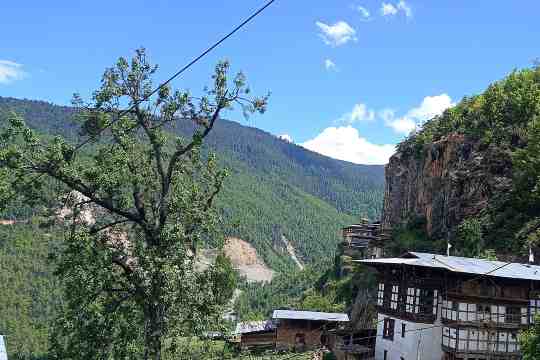
Dzongdrakha Goemba
Dzongdrakha Gomba, also known as Mini Taktsang, is a serene site located above Bonde village on the western edge of the Paro Valley. A group of four temples, this structure is very different from other temples and monasteries in Paro. The four temples are of Maitreya (future Buddha), Guru Rinpoche, Tsheringma (goddess of longevity) and Drolma (star). It is a place where you can learn about Bhutanese stories, folklore and urban legends and myths.
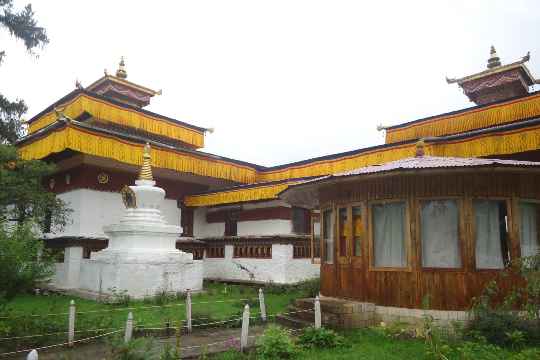
Kyichu Lhakhang
Dzongdrakha Gomba, also known as Mini Taktsang, is a serene site located above Bonde village on the western edge of the Paro Valley. A group of four temples, this structure is very different from other temples and monasteries in Paro. The four temples are of Maitreya (future Buddha), Guru Rinpoche, Tsheringma (goddess of longevity) and Drolma (star). It is a place where you can learn about Bhutanese stories, folklore and urban legends and myths. The temple is full of rich history and intricate frescoes of kings decorated in the past. There are also statues and sculptures of great Buddhist teachers. These idols include the famous Guru Rinpoche and Kurukulla, holding a bow of arrows made of flowers. Next to the statue of Guru Rinpoche is a shrine containing the ashes of the revered Nyingma Buddhist scholar, Dilgo Khentse Rinpoche.
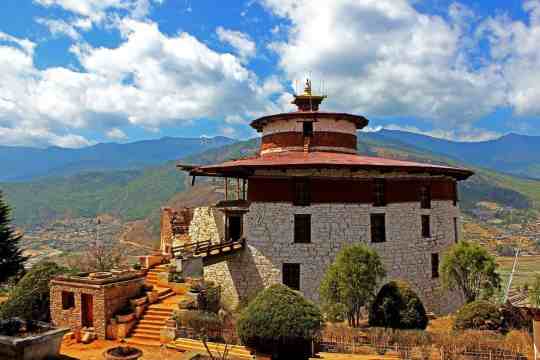
The National Museum of Bhutan
Located in Paro Ta Zong, the National Museum of Bhutan is sure to answer the questions of history buffs. The popular tourist attraction is a cultural museum which was established in the year 1968 to house some of the best specimens of Bhutanese art including bronze paintings and sculptures. Today the museum houses more than 3,000 works of Bhutanese artifacts and artifacts including traditional weapons, costumes, armour, handcrafted tools and more than 1,500 years of Bhutan's cultural heritage. As tourists join in exploring the museum, they will come across natural history galleries and ritual objects that display objects such as daggers, hats, thunderbolts, robes, cymbals, musical instruments suitable for Buddhist ceremonies.

Paro Chu
Paro Chu is the lifeline river in Paro which starts from the Jomolhari mountain and flows through beautiful meadows and valleys and then enters the city of Paro. The river flows with plenty of turns between the mountains on either side of the river and sprinkles its water everywhere as it rumbles below. Nature lovers and photography enthusiasts will fall in love with this beautiful river. The river tops the list of places to see for adventure in Paro as the water has grade III currents and is ideal for white river rafting. The lower Paro Chu River is a great stretch for kayaking and the gentle waters are suitable for first time kayakers as well.

Tachogang Lhakhang Bridge
Popularly known as the Iron Chain Bridge, the Tchogang Lhakhang Bridge crosses Paro Chhu to Dzong. The 600-year-old bridge was built in the late 1300s by Thangtong Gyalpo, who is said to have built 108 bridges across Tibet and Bhutan. Made of wood and iron, this is the first bridge ever built in Bhutan. Built over the mighty Paro Chhu River, the bridge offers a short adventure ride to the Tchogang Lhakhang Dzong amidst beautiful mountain views, river waters below, the lush green Paro valley and the splendid view of the dzong above. To visit the Dzong, you have to cross this iron bridge. You might be a little apprehensive at first but walking on the bridge is a great fun activity.

Zuri Dzong
The Zuri Dzong is one of the oldest dzongs in Bhutan dating back to the 12th century. Rich in history and royal in values, protected by double walls and a bridge, this five-storey building is also an ideal place for a walking tour. This is the oldest jong in Bhutan. The frescoes in the upper chapel depict the rich history and heritage of this fort, which is dedicated to the protector Za. Local people believe that there used to be a cave here, where the fort now stands and the Buddha meditated inside the cave.
Best Travel Packages For Paro
Find the best deals on Paro Tour Packages for solo, family & group travelers.
Looking for a custom trip plan?
It only take 2 minutes to plan your own holiday itinerary.

